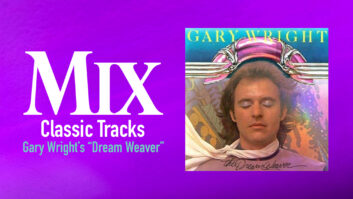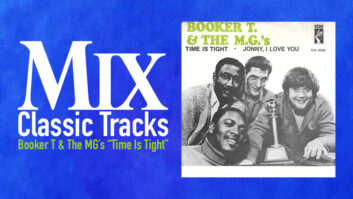
Whenever the term “British Invasion” is bandied about, most of us think of those four cheeky lads from Liverpool. But there were more sounds coming out of the UK in those early days than just the Mersey Sound; there was also the Tottenham Sound, represented by The Dave Clark Five. The group’s first U.S. hit, “Glad All Over,” knocked The Beatles’ “I Want To Hold Your Hand” out of the top spot in England, and the group quickly gained a huge following both there and in the States.
Drummer Clark had formed the band in 1957, and its signature lineup had fallen into place by 1960, when lead singer and keyboardist Mike Smith joined the group.
By 1962-63, the group had established a stronghold at The Tottenham Royal, a former North London dance hall. Like many bands at the time, the group’s repertoire comprised pop hits of the day, though the DC5 added something more. “We used to play the American military bases in the UK, and during intermission, they’d put these records on the jukebox, and ask us, ‘Can you play them when you come next week?’” Clark recalls. “And we’d say, ‘Well, if you let me have a copy of them, we’ll learn them.’” They were in demand.
When the band started at the Tottenham, they played for 700 to 800 people, but their popularity quickly rose. “We ended up playing to over 6,000 people a night, three or four nights a week. And you’d play three-and-a-half hours,” Clark recalls. “It was a great way to pay your dues.”
The group soon gained the attention of record companies, as well, among them Decca, which asked the band to come for a recording test at their Hampstead studio—the same place The Beatles had auditioned more than a year prior and were turned down.
The DC5 were assigned a young producer, who insisted they not record any of their own material. “We had been writing our own, and recording demos for other artists, like Gerry and the Pacemakers,” Clark says. “I thought, ‘This is crazy.’ So I said, ‘No.’ I told the guys, ‘Look, we’re packing in 6,000 people a night. We’ll make our own record.’”
Clark had the band record The Contours’ “Do You Love Me,” which the group had been doing live to great reception and which was released on Columbia in the UK in October 1963. But another band—Brian Poole and The Tremeloes—had their own take on the song and it went to Number 1, leaving Clark’s version essentially unnoticed. “I said to the guys, ‘From now on, we’re not gonna do anybody else’s songs. We’re gonna write our own song.’ And that’s why ‘Glad All Over’ came up.”
Key to the experience of a Dave Clark Five show at the Tottenham was a bit of audience participation, typically involving a Clark drum break, getting the audience stomping their feet in time to his playing. “I’d actually pay somebody 5 Pounds to go switch all the lights on and off in the ballroom, in time with the stomps,” he says. “That’s what gave Mike and I the idea for ‘Glad All Over,’” whose chorus features a can’t-help-yourself “bomp-bomp” “Glad all over!” chorus.
Clark rounded up the band once again for a session at Lansdowne Studios, where the group had already been doing demo recordings. Built in 1958 by producer Dennis Preston and engineers Joe Meek and Adrian Kerridge, the studio was housed in Lansdowne House, a former artist apartment complex constructed in 1904 in the Holland Park section of London.
The studio, in September 1963, when “Glad All Over” was recorded, featured a 12-input/2-output BRED console ordered by Meek from EMI’s Hayes electronics plant, which also built other recording equipment, most famously for the company’s Abbey Road studio. There was a single Ampex 300 Series 4-track recording machine, supplemented by two EMI TR91 stereo and one TR91 mono ¼-inch machines, the latter used for mono mixdowns and tape delay effects.
The band worked with producer/engineer Kerridge, who had joined the studio in 1959 following his service in the military, and helped Meek build the facility (including custom modifications to the Hayes-built recording console). The original production credit read the sly, “Adrian Clark,” a combination of his and Clark’s names, for reasons that made sense at the time.
“I thought he was brilliant,” Clark says of Kerridge, who recorded most of the band’s early core hit catalog. “He was a master and was into the live sound, so he was great to work with.” Kerridge was keen to apply the studio techniques he had learned from Meek to get Clark what he was after. “Dave was shrewd,” the engineer states. “He knew what he wanted.”
And what Clark wanted was that live Tottenham Sound, which is indeed the sound heard on “Glad All Over” and all of the group’s records from the era, particularly the singles. “We were basically a live band,” Clark says. “So I believed we should try to get a live sound.”
The Dave Clark Five pose for a “working” studio shot at Lansdowne, fall of 1963 (L-R): Rick Huxley, Mike Smith, Dave Clark, Denis Payton, Lenny Davidson. Photo: Courtesy of Dave Clark.
The recording process would begin with Clark and Smith demoing a song. “Mike and I would do a recording together on a little Tandberg tape recorder, just so that I knew that the routine would work when we went in the studio,” Clark explains. “I’m not somebody who goes into the studio and writes a song and spends all that time in there doing it. I always look at time in the studio as something special. When you have a routine ahead of time, then, when you’re there, you get a buzz. Because you know what you’re doing.”
Clark and Kerridge would spend ample time getting solid drum, guitar, bass and sax sounds—drums, particularly the signature “stomp-stomp,” being key. “I’d take the front skin off the kick drum and place the mic inside on a blanket,” Clark explains. The stomp, says Kerridge, was achieved by powerful hits by Clark on floor toms and his kick.
Because the recordings were independently produced by Clark—a somewhat unique arrangement in the early ’60s—he and Kerridge could push levels to a higher degree than, say, George Martin and Norman Smith would be permitted at Abbey Road, due to EMI’s more strict studio guidelines. “We took it to the limit,” Clark says. “And if we hadn’t been independent, we wouldn’t have been able to do that. But I just felt you needed to re-create that excitement that you got when you were playing live.”
A live performance also meant keeping the musicians excited about the recording. “We’d never go more than three takes on a song,” Clark says. “I always believed that if you went through any more than that, it becomes automatic. If we went through three takes and didn’t get it, we would just stop and go down to the pub for a beer, and then come back and try it again.”
Kerridge would make full use of the Ampex tape machine’s four tracks. “I’d record the rhythm track, typically, onto tracks 1, 2 and 3, and then I’d always leave a track open for Mike’s vocal,” he recalls.
For “Glad All Over,” drums, Rick Huxley’s bass and Lenny Davidson’s rhythm guitar were on one track, Smith’s Vox organ and Denis Payton’s saxophone on another, and the third contains live vocals—Smith’s, plus the band in backing. A second Smith vocal, recorded onto the fourth track, offers a stronger lead performance, as well as harmony to his first pass, as needed.
“I actually rarely double-tracked Mike,” Kerridge states. “I always preferred to get a live lead vocal performance from him because the band reacts to it while they’re playing. It makes a whole performance.”
Recorded typically with a Neumann U 47, Smith’s vocal technique was not only beautifully rock ‘n’ roll raucous when required, but he exhibited expert breath control, to the point of making a pop screen unnecessary. “He was an amazing vocalist, I think one of the most underrated,” Clark notes. “Mike not only had great range, but he had fabulous control. Adrian would put a candle in front of the mic, and if he blew it out, he was doing it wrong. He could sing and never make a ‘pop.’” Notes Kerridge, “I think the success we had with the Dave Clark Five was because of that great up-front sound, and Mike Smith’s vocal was a big part of that.”
Unlike bigger studios, such as Abbey Road, Lansdowne at the time had only one 4-track tape machine. So any overdubs were performed during the mix while Kerridge mixed in mono to a ¼-inch tape. “We’d add a sax, Denis playing a tambourine, whatever was needed,” Clark explains. In the case of “Glad All Over,” a live guitar overdub by Lenny Davidson, playing quick, muted plucks, was added during the mix.
A generous amount of tape echo was added (courtesy of either an EMI TR91 or a later Ampex 351), most clearly on the second of Smith’s vocals, as well as reverb. Lansdowne had two reverb chambers: a true reverb chamber, designed and built by Meek and Kerridge, used most typically, and another, which took advantage of the old brick building’s tall stairwell, with mics at each end. “We usually used the reverb chamber, but we would occasionally use the stairwell version, for special effect,” Kerridge explains.
“It had a great sound,” Clark notes, “but if a resident came down the stairs while you were using it, you had to start all over.” Adds Kerridge, “It would upset the residents when we’d use it. They used to get angry.”
Like most recordings of that time, the mono mix was . . . the only mix. “I didn’t even attempt a stereo mix until several years later, when stereo had really come into play more and fans demanded it, but I never released it,” Clark explains. A stereo mix does exist (of course, missing the live overdubs made during the mono mix). But “Glad All Over’s” mono mix just screams of rock ‘n’ roll—an MP3 sounding much like the song would have sounded played loud as a 45 rpm single on a teenager’s record player in 1963, complete with its own genuine, inherent distortion (it was released in February 1964 in the U.S.).
“The stereo mix doesn’t sound the same, mostly because of the spatial separation,” explains Kerridge, currently working on a book detailing his recording experiences. “It was specifically recorded for mono; there was no stereo thought in mind. It was specifically recorded as a mono single.”
Clark agrees. “The early mono mixes are far superior, particularly for groups of our era. I spoke to Phil Spector about this in the ’60s. Mono just had its own dynamic. It was forceful and powerful—and loud!”







